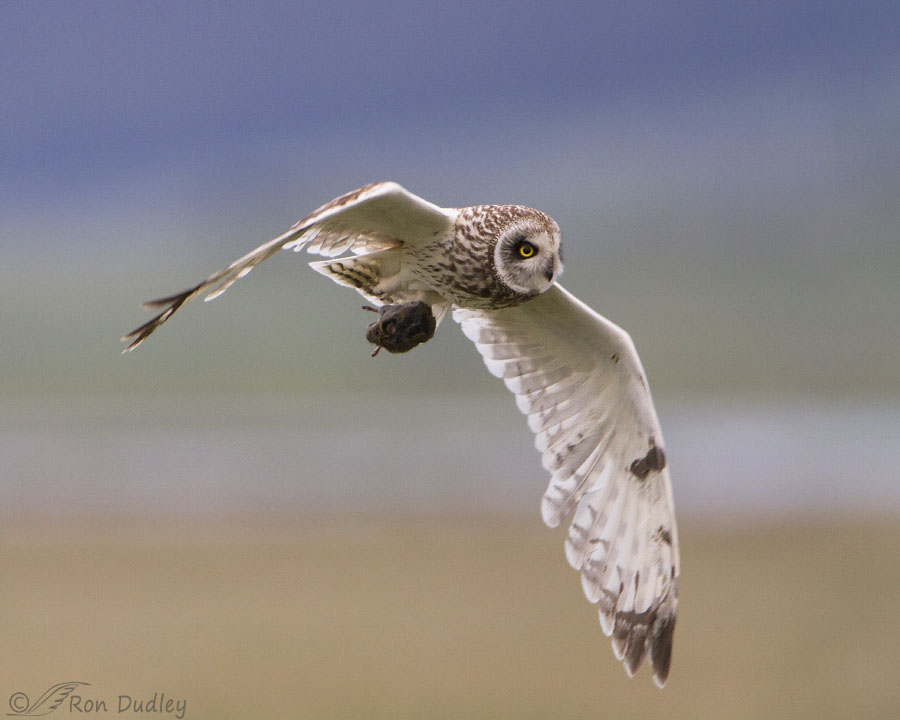Very few low light flight shots appeal to me but this one is an exception.

1/1000, f/5.6, ISO 800, Canon 7D, Canon EF 500mm f/4L IS USM + EF 1.4 III Extender, not baited, set up or called in
I took the photo on the evening of June 25, 2010 as this male Short-eared Owl flew past me with a vole in his talons at Red Rock Lakes NWR. It was cloudy so the light was low but just before he approached me the clouds in front of the sun thinned just enough to provide sufficient light on the owl to get barely enough shutter speed for a bird in flight. I got a series of shots of him with the still-shaded mountains in the background and I’ve always loved this layered effect with the dark blue above.
It appears to me that the vole might still be alive (they often are in this situation). It looks like a fat little guy partly because it’s doubled over and possibly reaching behind it in an attempt to bite the foot of the owl (notice its splayed rear legs). When they’re bitten raptors sometimes drop their prey in flight. Rehabbers tell me that raptors often have old scars on their feet and legs from rodent bites that can become infected.
But then again it might be doubled over just because it’s dead and the air currents in flight forced its body into that position.
I’ve posted other shots in the series but never this one because the owl was too close to the right side of the frame to give me the composition I preferred. I had three choices – add canvas on the right side, make it a vertical composition or have the bird centered in the frame. I try to avoid adding canvas whenever possible and I thought the vertical composition looked contrived so I chose to center the bird.
This is the first time I’ve seen the processed photo. I like it much better than I thought I would.
Ron


Wow!!! Stunning capture and perfect background, well done!
Beautiful photo! The bird is beautifully captured and that color fade in the background is fantastic! Thank you for sharing that with us!
Stunning shot, Ron! The asymmetry of the wing positions tricks my eye into seeing a non-centered subject and provides an exciting sense of energy. They layered background is the icing on the cake (mmmm…cake 😉 ).
“asymmetry of the wing positions tricks my eye into seeing a non-centered subject”
Thanks for that excuse, Marty!
I echo the comments of others that the layered effect is stunning. The owl with the vole gets some points to make this a great photo. Wish I knew if the vole is still alive and if so, hopefully not hurting the owl.
Everything/everybody wants to avoid destruction and death.
Thanks Ron
Thanks, Alice. I looked at a big crop with the vole in it and I still couldn’t tell for sure if it was still alive.
Add me to those who love the layered effect.
I needed an image like this today. Wish me luck while I wrestle with recalcitrant (and lying) tradesmen.
My money’s on you, EC. I’ll bet you can hold your own… 🙂
The company concerned moved (v quickly) into full on grovel mode. And as I type, tradies are here rectifying the issue. As they should.
PS: I suspect they felt a little vole like under the weight of my displeasure.
I pretty much knew that would be a safe bet…
That layering effect is amazing – sort of like a watercolor wash behind the bird!!
I like your comparison, Joanne.
Super shot, love it!
Thanks, Dick.
Gorgeous shot! I like all the feather details as well as the layered background. I think centering the Owl was definitely the best choice.
Susan, of the 3 choices I had I also think that option was the best.
Beautiful shot, Ron! 🙂 The background really contributes to the shot and helps the owl stand out………. All I saw was the owl and vole – didn’t think about how tight the shot was! Coffee maker quit this morning – I’m “cranky”………..
I’d be cranky too, Judy. Probably downright nasty! Thanks.
There is something about the contrast between the soft pastel background and the sharp image of the subject that is both calming and a bit unsettling at once. Nicely done.
Interesting observation, Lyle. Thank you.
Truly fine image, Ron and I agree the layered background enhances it.
Thanks, Gary. I agree, the background makes a big positive difference here.
I never thought it looked tight being centered. I hear you about giving it some room to fly towards, but this works fine. I am focused on the bird and vole…well done at 1/1000.
Thanks, Zaph. I don’t it’s too tight either but I do wish he had more room in the frame to fly into.
That is beautiful! The layered effect is stunning. I’m glad you like it… 🙂 There is just that special look ShortEars have; it must be their eyes that draw you in and keep you there forever. This is really a special photo.
I think it’s pretty special too. Yes, those bright yellow eyes surrounded by the facial disk really stand out, even in low light like this. I don’t think a raptor with dark eyes would work nearly as well in this situation. Thank you, Kathy.